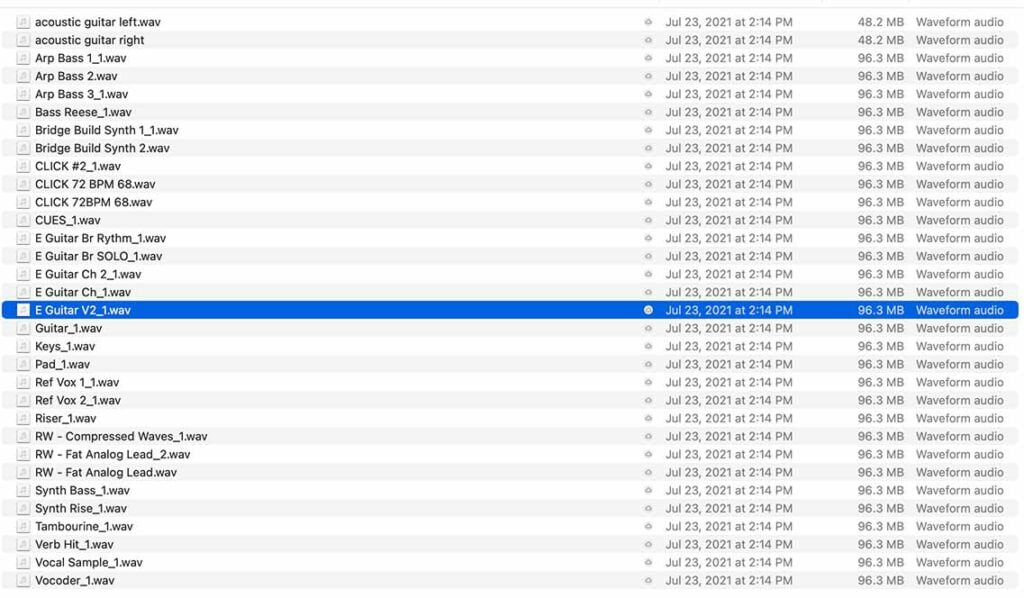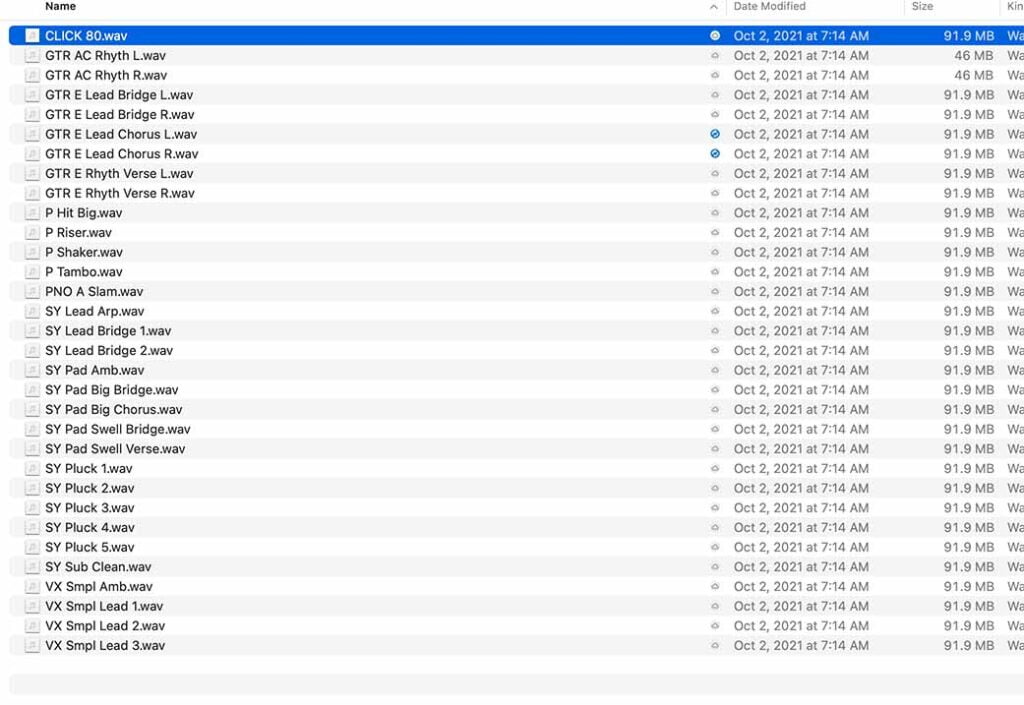Blog / My EPIC Track Naming Scheme That Will Change Your Life (and Make Your Mix Engineer Love You)
Properly naming organizing your files when creating music is a lot like going to the gym: we all know we should, but man it’s hard to find the motivation – especially when in the creative zone.
Today I want to share the file/track naming scheme that’s literally changed my life. If you adopt this even in your writing sessions, I guarantee that you will be happier, healthier, and more creative. You’ll spend less time trying to find the right files, and more time focusing on the creative stuff. Plus the people you collaborate with (especially your mix engineer) will love you.
Here’s a screenshot of a typical folder of multitracks:

While it’s nice that everything is generally labeled (please never send a file named audio_81#2.cm.wav), the main problem is that it’s not actually sorted in a way that makes finding the file you’re looking for easy. If you’re looking for all the drums, they’re scattered among 20-100 other files. The acoustic guitars are in a different zip code from the electric guitars even though they’re both guitars.
We want to design a naming scheme that sorts everything FOR US AUTOMATICALLY. The best way to do that is to hack the alphabet. Computers sort by name by default. SO if we start any track that’s a drum or a guitar with the same word or prefix, they’ll automatically get grouped together.
Extrapolating this concept, if we start labeling tracks where the start of the filename is general then move to be specific, the bulk of the sorting will happen automatically.
Here’s the broad hierarchy of this system:
Prefix -> Subtype -> Arrangement Descriptors -> Section Descriptors -> Layers/Doubles -> Multi-Mic/Sources Descriptors
And in practice this looks something like:

Notice how not only is each type of instrument together, but each SUBTYPE of an instrument is together. You have all the guitars together, but ALSO the electrics are separate from the acoustics. All the synths are together, but also the pads are separated from the leads, etc.
Pretty sexy, right? Let’s dive into this naming convention more.
If you follow nothing else from this guide, PLEASE start prefixing your files. This is probably 85% of the battle.
| Class | Prefix |
|---|---|
| Drums | D |
| Percussion | P |
| FX | FX |
| Bass | Bass |
| Guitars | GTR |
| Piano | PNO |
| Synth | SY |
| Organ | ORG |
| Strings | ST |
| Vocals | V |
| Vocal Chops/Effects | VX |
Everything is designed to organize things by type, but still be short enough so it doesn’t take up screen real estate.
So let’s not stop at just prefixing files. The track naming scheme goes deeper than that…
The subtype immediately follows the prefix. This is where you separate the acoustic guitars from the electric guitars, the pads from the leads, etc. For instance:
or
or
or
or
Once again, this makes sure that we sort each kind of instrument by its brothers and sisters.
Now it starts becoming more subjective based on the organizational needs of the project. AFTER you’ve subtyped each track, you start describing how it’s used in the arrangement so that all the rhythm electrics are separate from the lead electrics,
Some descriptors could be
This is where things start being used if needed. If you have to split out a particular instrument into different tracks for each section of the song (different tones or overlapping parts), now is where you describe where it goes in the structure.
After you’ve properly described the type, subtype, arrangement, and section now describe if it’s a layer or a double of a part.
You can use a number if it’s just adding a layer with a different tone.
If you’re doubling something with the same tone (usually the lead vocal on the chorus for extra thiccness), use “DBL”
Say you have an instrument that has two sources, now you label the source of each thing.
D Snare Top
D Snare Btm
D Kick IN
D Kick OUT
Bass DI
Bass Amp
GTR E Rhyth Chorus Amp
GTR E Rhyth Chorus DI
I use this naming scheme from the very START of every session. Even if I’m just writing a song for fun. It helps down the line instead of having to go through and REname everything at a later date. I get it might not be your first instinct, but it gets easier as time goes on!
If you have a question on how you might label something, drop it in the comments and I’ll reply and update this guide as needed!
D Kick In
D Kick Out
D Snare Top
D Snare Btm
D Rack
D Floor
D Hat
D OH L
D OH R
D Room L
D Room R
P Tambo
P Shaker
P Hit Big
P Sweep
P Cym Swell
P Boom
P Claps
Bass DI
Bass Amp
GTR AC L
GTR AC R
GTR E Rhyth Verse L
GTR E Rhyth Verse R
GTR E Rhyth Ch L
GTR E Rhyth CH R
GTR E Lead L
GTR E Lead R
GTR E Solo
GTR E Solo Harm
PNO A Chords L
PNO A Chords R
PNO A Ctpt L
PNO A Ctpt R
PNO E Rhodes L
PNO E Rhodes R
SY Sub Clean
SY Sub Dirt
SY Bass Arp
SY Bass Sidechain
SY Pad Amb
SY Pad Big
SY Pad Big Sidechain
SY Lead Glide
SY Lead Saw
ST Violin 1
ST Violin 2
ST Cello
ST Upright
VX Lead Drop 1
VX Lead Drop 2
VX Amb 1
VX Amb 2
V Lead Verse
V Lead Chorus
V Lead Chrous Dbl L
V Lead Chorus Dbl R
V BGV Harm Alto
V BGV Harm Tenor
V BGV Dbl Alto